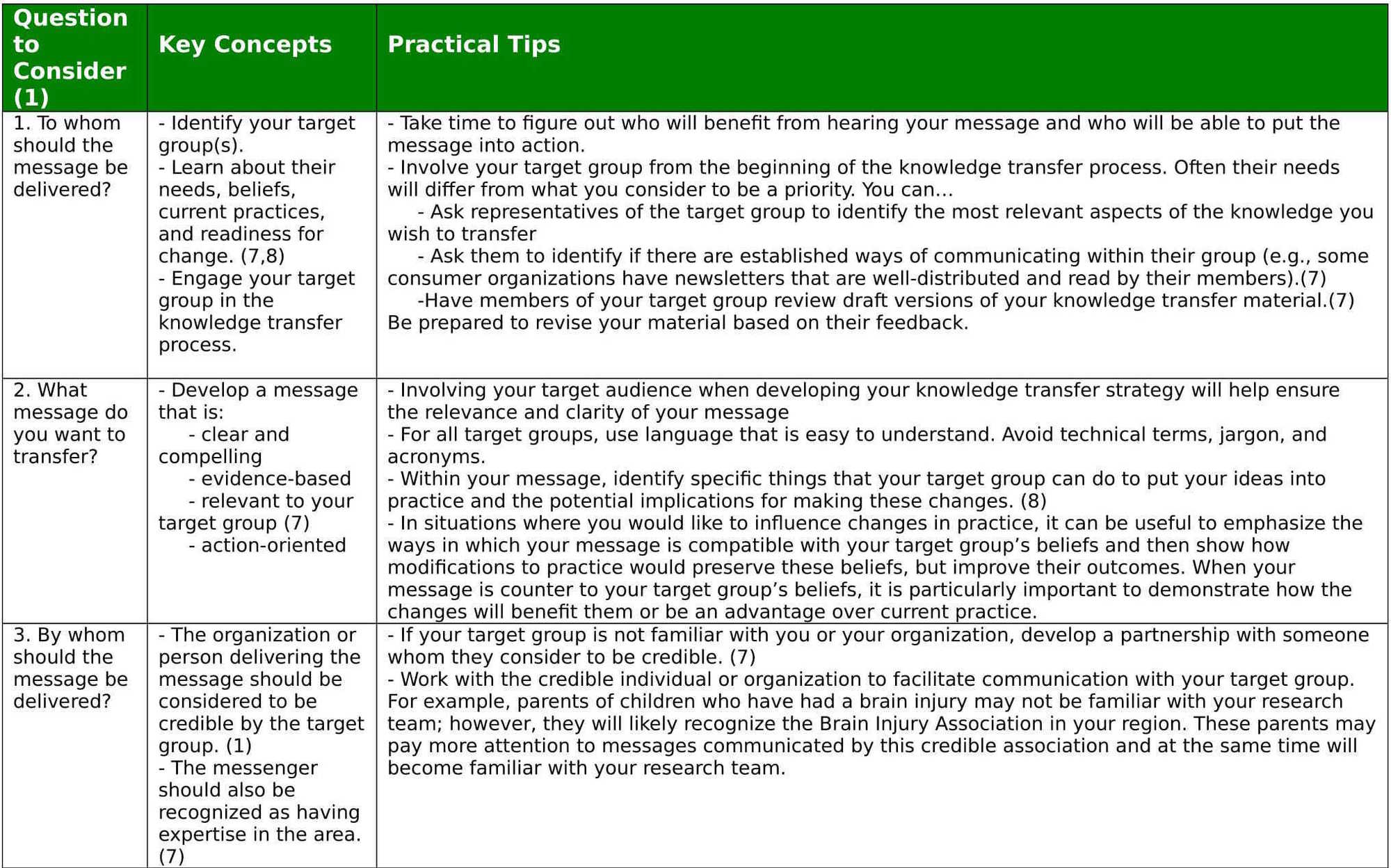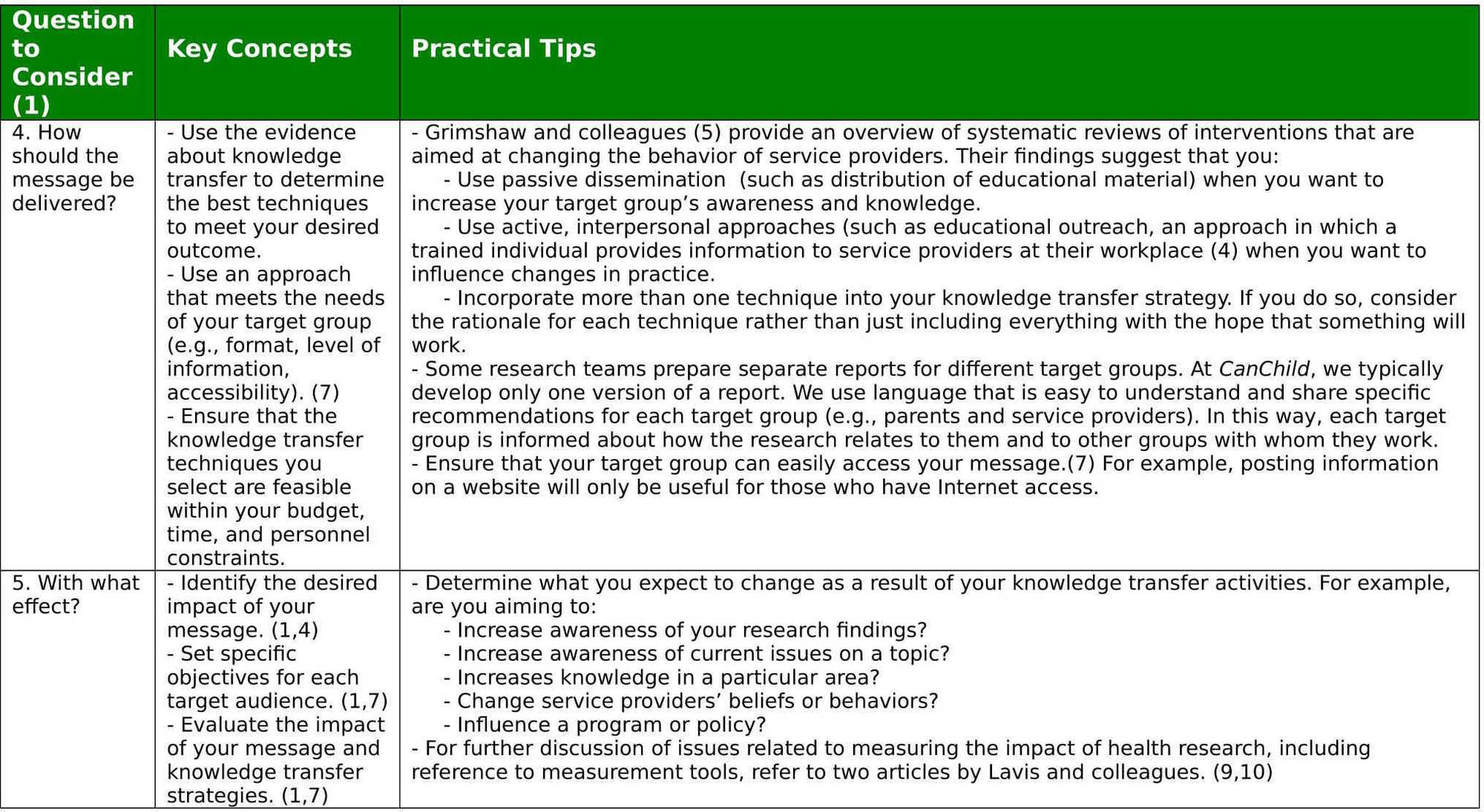Knowledge Transfer in Health Care
Why is Knowledge Transfer Important?
In health care, there has been increasing recognition of the need to facilitate the transfer of research evidence into clinical practice and policy development. To meet this need, health care researchers and granting agencies have begun to place more importance on the processes used to communicate knowledge from research studies and to promote knowledge uptake by appropriate audiences (e.g., service providers, managers, and policy makers). This Keeping Current brings together ideas from the literature and from organizations that are dedicated to improving knowledge transfer practices. It is intended to help researchers develop knowledge transfer strategies that are specific to their area of research and target audiences.
What Is Knowledge Transfer?
The Program in Policy Decision-Making at McMaster University defines knowledge transfer as……a process by which relevant research information is made available and accessible for practice, planning, and policy-making through interactive engagement with audiences. Knowledge transfer is supported by userfriendly materials and a communication strategy that enhances the credibility of the organization. Where relevant, knowledge transfer reinforces key messages from the research.1 There are many terms that are used to describe this knowledge transfer process. These terms include: research transfer, knowledge exchange, knowledge translation, knowledge mobilization, research uptake, research/knowledge utilization, and dissemination. Although these terms are similar and are sometimes used interchangeably, each one has a slightly different meaning. In this Keeping Current, we will use the term “knowledge transfer”.
How Can Knowledge Transfer Be Accomplished?
There are many different techniques that are available to share knowledge. These techniques range from traditional approaches, such as distribution of education materials and conference presentations, to more recently popular approaches, such as the use of knowledge brokers (2) and communities of practice (3) The Institute for Work and Health provides definitions and examples of many of these techniques in their knowledge transfer and exchange workbook. (4)
With so many possible techniques, how do you decide which ones to use? The literature suggests a number of principles that are important to consider when planning knowledge transfer activities. The Program in Policy Decision-Making has incorporated these principles into five questions to help researchers develop a “systematic approach to knowledge transfer”. These questions are presented in the following table and provide a framework for presenting concepts and tips from the literature (as referenced) and from the experience of CanChild researchers. The concepts and tips are not all-inclusive, but provide key ideas that will be helpful as you develop or improve upon your knowledge transfer strategies.
Ideas for developing a knowledge transfer strategy


For your interest, a pdf version of the table has been provided for download.
Resources for developing a knowledge transfer strategy
Knowledge transfer and exchange: a workbook
Organization: The Institute for Work and Health
- This workbook is designed to help users develop knowledge transfer strategies. It contains worksheets that are based on the five knowledge transfer questions presented in the previous table. The workbook is not available on the website – you must request it by contacting their organization.
Developing an effective dissemination plan
Organization: National Centre for the Dissemination of Disability Research
- This resource presents “Ten elements of an effective dissemination plan” and provides questions related to the ten elements that are intended to guide the development of a dissemination plan. There is a particular focus on end-users of the research. This organization defines dissemination broadly and the elements relate closely to the definition of knowledge transfer presented in this Keeping Current.
Improving Knowledge Transfer
Organization: The Max Locke Centre
- The information, case studies, and resources are specific to urban development researchers in the United Kingdom; however, the eight guides provide insight and recommendations that are easily transferable to other areas of research.
Resources for the written components of a knowledge transfer strategy
Writing health information for patients and families: A guide for creating patient education materials that are easy to read, understand and use
Authors: L. Wizowski, T. Harper, & T. Hutchings (2002)
Organization: Hamilton Health Sciences
- This resource promotes the use of plain language and provides specific steps to consider when writing and designing educational materials. Although the focus is on “patient” education materials, the concepts are relevant when preparing materials for any target group.
Communication notes: Reader friendly writing - 1:3:25
Organization: Canadian Health Service Research Foundation
- This two-page reference provides tips for writing reports for decision makers. It recommends writing a one-page overview, a three-page executive summary, and a full report that is no longer than 25 pages.
Toolkit: Disseminating research online
Organization: Global Development Network
- This toolkit provides comprehensive information and practical strategies for sharing information electronically. It covers topics such as effective online communication, helping users find your research, and tips for individuals who do not have a website.
